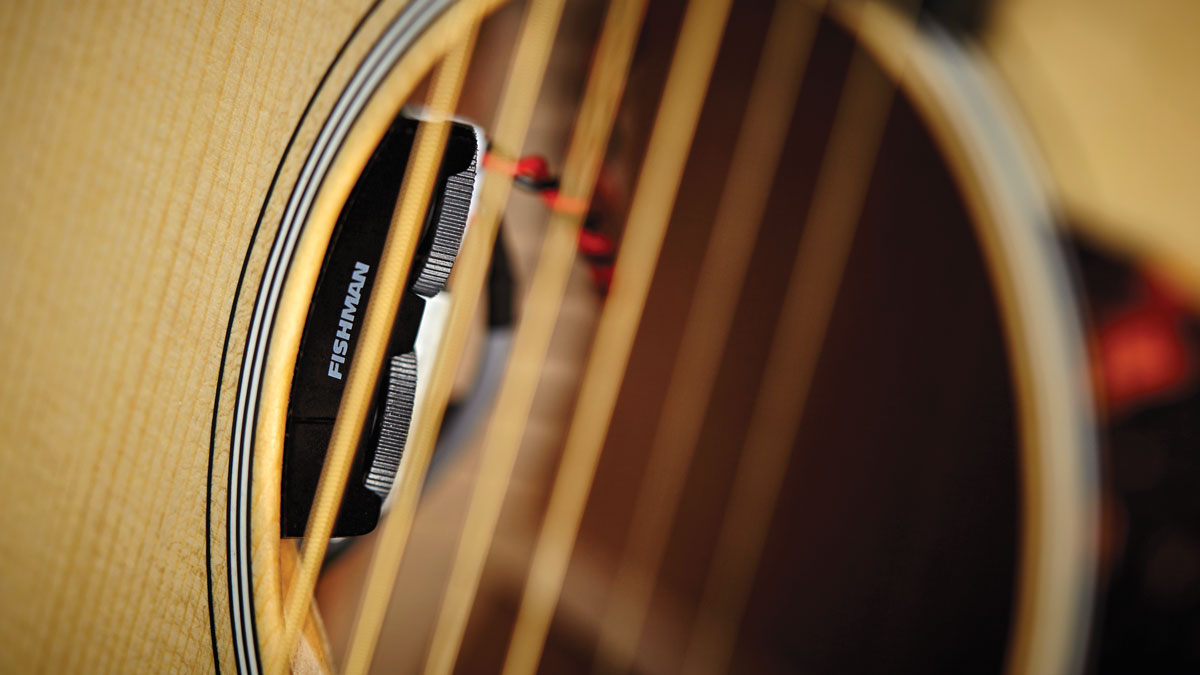MusicRadar Verdict
Faultless in both concept and execution.
Pros
- +
Punchy midrange tones. Classic Martin sound. Smaller body makes for a more comfortable playing experience. Excellent build quality and materials.
Cons
- -
Lacks the depth of a full-sized dreadnought.
MusicRadar's got your back

Martin Dreadnought Junior

Fishman

Bridge
Slightly smaller but perfectly formed, Martin's Dreadnought Junior has 'electro-acoustic of the year' written all over it. Can it really be that good?
Today's acoustic guitar market is flooded with a few body shapes at lots of different price points. It makes choosing your fit more difficult than ever - is that dreadnought really better than that one, or that one?
These similarities are no doubt why more and more brands are offering something a little different: for example, smaller guitars for 'travel', or even bigger guitars, like baritones. In a crowded market, you have to be different.
But it's small that's becoming the new big in acoustic terms. There's Ed Sheeran and his lil' Martin, Taylor Swift with her Baby Taylor. Don't get us started on ukuleles...
"The Dread Junior might be downsized, but it's very grown-up in build, with all-solid wood construction"
So, where does this new Martin Dreadnought Junior fit into all of this? Well, exactly midway between Ed's Little Martin and a full-size Martin dreadnought. But it's not just size at play here.
Martin's entry-level ranges, like the X Series, are made in Mexico. And to keep prices low, those X Series guitars, for example, use high pressure laminate (HPL) back and sides, multi-piece necks and Richlite synthetic fingerboards.
Now, that might suit you, but if you hanker for a 'proper' Martin-style solid-wood dreadnought, you'll be looking at a DRS2 and a sizeable wad of cash at £799. Enter the Dread Junior.
Want all the hottest music and gear news, reviews, deals, features and more, direct to your inbox? Sign up here.
Like Taylor's Big Baby, the Dreadnought Junior is 15/16ths of the size of that DRS2 or any other contemporary Martin dreadnought. In reality, it's not much of a down-size: 360mm (14.2 inches) wide and 112mm (4.41 inches) deep as opposed to the full-size model being 397mm (15.6 inches) and 124mm (4.88 inches) deep.
Factor in the scale length, which is reduced from Martin's long scale of 645mm (25.4 inches) down to 610mm (24 inches), and the Junior looks like a perfectly proportioned, slightly diminished Martin.
Unlike Martin's own X Series, or indeed, the minimalist cool of Taylor's Big Baby, the Dread Junior might be downsized, but it's very grown-up in build, with all-solid wood construction, proper mortise and tenon neck joint, a bound top edge and simple soundhole rings.
Internally, the X bracing and struts are finely done in classic style. Then there's that headstock, again slightly downsized with regular small-button tuners and the all- important, and full-size, logo.
The only nod to modernism, or indeed cost, in terms of the materials are the synthetic ebony Richlite fingerboard and bridge, which you'll find on the more costly DRS2, and the generic 'select hardwood' specification for the neck, which looks like one-piece mahogany. But we have a full-size nut width and string spacing, also at the bridge, and a subtly V'd C shape to the profile, along with vintage-style small frets.
"It retains a Martin stamp: classic, old-school and a fine picker's choice, too"
Last, but far from least, is the hand-rubbed natural oil finish, which doesn't protect the guitar in the same way as a more robust modern gloss or satin finish, and will require regular maintenance, but while it's a quick finish to apply, the sanding of all the parts needs to be perfect and it certainly is.
The only giveaway to the Junior's electro status are the discreet soundhole-placed volume and tone controls - you can also see a battery bag by the neck block - but it's a Fishman Sonitone system and should be stage-ready.
Swapping between a full-size Martin dreadnought and the Junior, you notice the downsizing but in a quite positive way - played seated, it's much less cumbersome and a really comfortable strum.
The more compact fret positions are noticeable the higher up the 'board you go, but along with a slightly lower string tension, we soon get used to the feel. It might be aimed at smaller, younger hands but older, bigger ones adapted surprisingly easy with lower-position chording slightly less of a stretch.
It might not have the huge depth or width, harmonically speaking, of the full-size dreadnought, but there's a punchy midrange and a slightly textured edge, less smoothness (that is probably down to the finish), but it retains a Martin stamp: classic, old-school and a fine picker's choice, too. Plugged in, we get a slight treble lift over the acoustic sound, but that's easily tamed with some outboard EQ.
Put simply, it's a cracking guitar, far from a Guitar Shaped Object. For serious younger players, it's a great entry into Martin's heritage, but the more compact size means that many a more mature player will enjoy it, too.
Dave Burrluck is one of the world’s most experienced guitar journalists, who started writing back in the '80s for International Musician and Recording World, co-founded The Guitar Magazine and has been the Gear Reviews Editor of Guitarist magazine for the past two decades. Along the way, Dave has been the sole author of The PRS Guitar Book and The Player's Guide to Guitar Maintenance as well as contributing to numerous other books on the electric guitar. Dave is an active gigging and recording musician and still finds time to make, repair and mod guitars, not least for Guitarist’s The Mod Squad.
